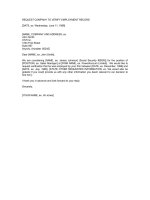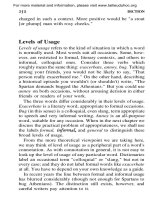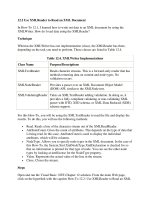Tài liệu Ten Steps to Equity in Education doc
Bạn đang xem bản rút gọn của tài liệu. Xem và tải ngay bản đầy đủ của tài liệu tại đây (234.9 KB, 8 trang )
© OECD 2008
ORGANISATION FOR ECONOMIC CO-OPERATION AND DEVELOPMENT
Policy Brief
JANUARY 2008
Ten Steps to Equity in Education
Introduction
Education plays a key role in determining how you spend your adult life – a higher
level of education means higher earnings, better health, and a longer life. By the
same token, the long-term social and financial costs of educational failure are
high. Those without the skills to participate socially and economically generate
higher costs for health, income support, child welfare and social security systems.
So a fair and inclusive system that makes the advantages of education available
to all is one of the most powerful levers to make society more equitable.
Education has expanded significantly in the past half-century, but hopes that this
would automatically bring about a fairer society have been only partly realised.
Women have made dramatic advances, but overall social mobility has not risen
and in some places inequalities of income and wealth have increased.
As ever more students go on to university or professional education, many are
still being left behind. Across OECD countries nearly one in three adults have
only primary or lower secondary education – a real disadvantage in terms of
employment and life chances.
At the same time, increased migration poses new challenges for social cohesion
in some countries while other countries face longstanding issues of integrating
minorities. Fair and inclusive education for migrants and minorities is a key to
these challenges. Equity in education enhances social cohesion and trust.
This Policy Brief looks at how to improve equity in education in three key policy
domains: the design of education systems, practices both in and out of school,
and resourcing. It proposes ten steps which would help reduce school failure
and dropout rates, make society fairer and help avoid the large social costs of
marginalised adults with few basic skills. ■
What are the
challenges for equity
in education?
How to improve
the design of
education systems?
How to improve
practices in and out
of the classroom?
How to improve
resourcing for equity
in education?
For further
information
For further reading
Where to contact us?
2 ■ © OECD 2008
Policy Brief
TEN STEPS TO EQUITY IN EDUCATION
Equity in education has two dimensions. The first is fairness, which basically
means making sure that personal and social circumstances – for example gender,
socio-economic status or ethnic origin – should not be an obstacle to achieving
educational potential.
The second is inclusion, in other words ensuring a basic minimum standard of
education for all – for example that everyone should be able to read, write and do simple
arithmetic. The two dimensions are closely intertwined: tackling school failure helps to
overcome the effects of social deprivation which often causes school failure.
Both equity and fairness are issues for OECD countries. Children from poorer
homes in most OECD countries are between three and four times more likely to
be among the poorest scorers in mathematics at age 15 (see Figure 1).
And when it comes to inclusion, many students in OECD countries struggle
with reading and risk, leaving school without basic skills for work and life in
the 21st century. Significantly, there are big differences between countries (see
Figure 2).
Achieving the necessary reading and mathematical skills is often especially
difficult for migrants and minorities, who often lose out on both fronts – lower
performance and low socio-economic background. Approaches to overcoming these
hurdles include strengthening early childhood education and care, not streaming
immigrants into special education, improving language training and strengthening
teachers’ professional development to deal with multiculturalism. Measures
to reduce discrimination in the labour market can also increase incentives for
immigrants to obtain a good education.
Three key policy areas can affect equity in education: the design of education
systems, practices in and out of school, and how resources are allocated. The OECD has
developed ten practical steps that governments can take in these three areas to
enhance equity in education. ■
What are the
challenges for equity
in education?
FIGURE 1. HOW SOCIAL
BACKGROUND AFFECTS
PERFORMANCE IN
MATHEMATICS
Relative chances of
students in lowest and
highest socio-economic
group ending up with
very poor (below or at
Level 1) performance in
mathematics (2003)
0
1
2
3
4
5
6
Likelihood of students with the lowest SES to be lowest maths performers when compared
to
students with high SES
Icelan
d
Turk
ey
Canada
Japa
n
Greece
Fi
nlan
d
Norw
ay
Sweden
Sp
a
in
Port
ugal
1
Ital
y
Austri
a
Poland
Austra
li
a
Luxembou
rg
Kore
a
Ne
w Zealan
d
Irelan
d
Netherland
s
United
States
Sw
i
tzerland
Mexico
Denmar
k
Czec
h
Republ
i
c
Fr
a
nc
e
Germany
Hungar
y
Slovak
Repu
b
li
c
Belgiu
m
Odds ratio
1. For example, in Portugal, a student with low SES is three times more likely to be a low mathematics
achiever than a student with high SES.
Source: OECD (2006), Education at a Glance: OECD Indicators 2006, OECD, Paris.
© OECD 2008 ■ 3
TEN STEPS TO EQUITY IN EDUCATION
Policy Brief
The basic structure of education systems affects equity. Traditionally, education
systems have sorted students according to attainment. Evidence from studies
of secondary and primary schools suggests that such sorting can increase
inequalities and inequities, particularly if it takes place early in the education
process. Early sorting can also weaken results overall.
This prompts two conclusions: early tracking and streaming need to be justified
in terms of proven benefits; and school systems using early tracking should
postpone it to a later stage to reduce inequities and improve outcomes.
The socio-economic structure of education systems is also important. Secondary
school systems where there are large socio-economic differences between schools
tend on average to have worse results in mathematics and reading and a greater
spread of reading outcomes. Indeed, social background is more of an obstacle to
educational success than in systems without such socio-economic differences
between schools.
Selecting pupils on the basis of academic achievement tends to create great social
differences between schools. It also increases the link between socio-economic
status and performance – it tends to accelerate the progress of those who have
already gained the best start in life from their parents – and is also associated
with stronger performance at the top end of the scale in mathematics and
science. So academic selection needs to be used with caution because of the risks
it poses to equity.
Governments often allow parents a choice of schools, partly in the interests of equity.
But this may in fact increase the risk of inequity because better-educated parents
make better-informed choices. In many OECD countries, greater choice in school
systems is associated with larger differences in the social composition of schools.
The conclusion is that school choice requires careful management from an
equity perspective, particularly to ensure that it does not result in increased
differences in the social composition of schools. Popular schools are likely to be
How to improve
the design of
education systems?
FIGURE 2. HOW MANY
STUDENTS STRUGGLE
WITH READING
1
Percentage of students
below and at Level 1 of
proficiency in the OECD
PISA reading scale
2
(2003)
0
10
20
30
40
50
60
Below Level 1 (below 335 score points)
Leve
l 1 (from 335 to 407 score points)
%
Finlan
d
Kore
a
Canada
Ir
elan
d
Netherland
s
Aust
ra
li
a
Sweden
Ne
w Zealan
d
Denmar
k
Swit
ze
rlan
d
Po
l
an
d
Fr
ance
Belg
iu
m
Norway
Ic
elan
d
Japa
n
Cz
e
ch
Republic
Un
i
te
d
St
ates
Hungar
y
Austri
a
Sp
a
in
Port
ugal
German
y
Luxembou
r
g
Ital
y
Slovak
Repub
li
c
Greec
e
Russia
n Fe
derati
on
Tu
r
ke
y
Mexico
1. Countries are ranked in descending order of percentage of 15-year-olds in Levels 2, 3, 4, 5, and 6.
2. The PISA scale has six levels of proficiency. Level 2 represents the baseline at which students begin
having skills that allow them to use reading actively. Level 1 and below imply insufficient reading
skills to function in today’s societies.
Source: OECD (2004), Learning for Tomorrow’s World: First Results from PISA 2003, OECD, Paris.
4 ■ © OECD 2008
Policy Brief
TEN STEPS TO EQUITY IN EDUCATION
oversubscribed, and need ways to ensure an even social mix. This could include
selection methods such as lottery arrangements. Financial premiums to schools
attracting disadvantaged pupils may also help.
Students struggling within the system face a further risk as they get into the
final years of compulsory education – lack of future choice, and a high risk of
dropping out altogether. Between 5% and 40% of students drop out of school in
OECD countries, finishing with low skills and high rates of unemployment. The
reasons for dropping out include disenchantment with school, lack of support at
home, negative learning experiences and having to repeat years because of poor
performance.
The best cure is to stave off the risk of dropout as early as possible. Basic
schooling should support and engage those who struggle at school as well as
those who excel.
One way of improving performance and preventing dropout is to identify at-risk
students early and take action quickly. This means monitoring information on
attendance, performance and involvement in school activities, and having a
concrete response to improve outcomes and prevent dropout.
Upper secondary education needs to be attractive not just to an academically-
inclined elite, but also to offer good quality pathways without dead ends and
effective links to the world of work. Offering at-risk students good career
guidance and counselling, as well as making the curriculum more flexible and
diverse is helpful. Additional learning support at the end of secondary school may
also help to encourage students to stay in school.
Good quality vocational tracks are essential. Removing an academic hurdle from
entrance to general upper secondary education, and allowing access to tertiary
education from vocational programmes, as Sweden and Norway have done, can
increase the status of the vocational track.
In the modern knowledge economy, one shot at education which determines
once and for all your future life choices is not enough. But those who fail at
school often find it difficult to recover later on. In all OECD countries, those with
weak basic qualifications are much less likely to continue learning in adult life.
However, there are big differences between countries.
Second chances for those who lack basic education and skills can be provided in a
number of ways, including programmes that provide literacy training, work-based
programmes, and arrangements to recognise informal learning. In the United
States, almost 60% of dropouts eventually earn a high school credential (GED
certificate) through second chance education programmes. ■
What happens in the classroom obviously affects equity, but the relationships
between schools, parents and communities also matter. Student learning benefits
from an effective school-home relationship, but weak support at home can hold
back children from deprived backgrounds. Effective provision for migrants and
minorities in the education system is also a key challenge.
Making students repeat a year if they are not keeping up is a popular option – in
some school systems, up to one-quarter of students repeat a year at some point.
But it is costly and there is little evidence that children benefit from it. High
rates of year repetition in some countries need to be reduced by encouraging
alternative approaches in the classroom.
How to improve
practices in and out
of the classroom?
© OECD 2008 ■ 5
TEN STEPS TO EQUITY IN EDUCATION
Policy Brief
It is possible to improve classroom attainment with methods such as formative
assessment – a process of feeding back information about performance to student and
teacher and adapting and improving teaching and learning in response, particularly
with students at risk. “Reading recovery” strategies – short-term, intensive interventions
of one-on-one lessons – can help many poor readers to catch up.
Many countries could usefully follow the Finnish approach to learning difficulties,
which offers a sequence of intensifying interventions to draw back into the
mainstream those who fall behind. It certainly appears successful: only 1% of
Finnish 15-year-olds are unable to demonstrate basic functional reading skills,
while the OECD average is 7%.
For classroom interventions to work, however, teachers need support to develop
their techniques to help those pupils who are falling behind.
And classroom intervention is not enough – more than 20% of the learning time
of children in OECD countries takes place out of school, in the form of homework,
working with a tutor, or other activities. And attitudes at home, including parental
support for education, involvement in children’s learning and cultural habits like
having books around, are also associated with stronger school performance.
Expecting homework to improve performance may threaten equity, since
some children do not have the parental support needed to bring results. But
encouraging parental involvement – working with children at home and actively
participating in school activities – does improve results. Schools that foster
participation by parents, and help parents to support their children in their school
work tend to have better outcomes.
For this to work, schools need to target their efforts on improving communication
with parents in the most disadvantaged homes and to help develop home
environments conducive to learning. After-school homework clubs at school may
also help those with weak home support.
Minorities and migrants face particular difficulties, and systems need to respond
to their needs. Success in both education and employment varies widely between
immigrant and minority groups and between different countries. But in many
cases minority groups are less likely than others to participate in early childhood
education and care, more likely to be in special education and more likely to drop
out or end up in low-status streams. For some “visible minority” groups, labour
market discrimination is sometimes extensive. This limits employment prospects
and reduces the incentives to obtain qualifications.
In most countries, first and second generation immigrant students tend to
perform less well than their native counterparts in OECD assessments of
mathematics, science and reading, and analysis suggests that much of this is
explained by social background.
To combat these disadvantages, early childhood education and care is helpful
and provides a strong environment in which to learn a second language. Special
measures may encourage participation by immigrants’ children.
Where immigrant and minority groups are disproportionately streamed into
special education institutions, attention needs to be given to the risk of cultural
bias in the selection process and whether separate schooling is in the best
interests of the students involved.
6 ■ © OECD 2008
Policy Brief
TEN STEPS TO EQUITY IN EDUCATION
Newly-arrived immigrant children often need special language training, for
example, but this should not isolate the children from mainstream classes for
more than a year at most. Particularly in countries where immigration has
risen sharply, teachers need training to deal with language issues but also a
multicultural curriculum and teaching antiracism. ■
It is likely to prove difficult in many countries to increase education spending
to deal with equity issues, so it is perhaps more helpful to focus on targeting
existing education expenditure to ensure that it contributes to equity.
Clearly, education systems need to provide strong education for all, giving priority
to early childhood provision and basic schooling. Public provision of education
can foster equity if it counterbalances poor home circumstances at the outset of
children’s lives. But it may increase inequity if it offers a common resource that is
primarily claimed by those least in need of it.
There is strong evidence that early childhood education and care, alongside public
policy measures to improve the lives of young children, is the highest equity
priority. If fees for early childhood education and care are applied at all, they
should be moderate and remitted for those too poor to pay.
Basic education remains an equity priority because it includes the entire cohort.
Within this sector, particular attention should be given to efforts to sustain the
performance of those with learning difficulties.
Existing education resources are already being reallocated in ways that may not
help equity in basic education. There is pressure for money from an expanding
tertiary education system, for example. But while countries need a high quality
How to improve
resourcing for equity
in education?
BOX.
TEN STEPS TO EQUITY
IN EDUCATION
The OECD has recommended ten steps which would reduce school failure and
dropout rates, make society fairer and avoid the large social costs of marginalised
adults with few basic skills.
Design
1. Limit early tracking and streaming and postpone academic selection.
2. Manage school choice so as to contain the risks to equity.
3. In upper secondary education, provide attractive alternatives, remove dead ends
and prevent dropout.
4. Offer second chances to gain from education.
Practices
5. Identify and provide systematic help to those who fall behind at school and
reduce year repetition.
6. Strengthen the links between school and home to help disadvantaged parents
help their children to learn.
7. Respond to diversity and provide for the successful inclusion of migrants and
minorities within mainstream education.
Resourcing
8. Provide strong education for all, giving priority to early childhood provision and
basic schooling.
9. Direct resources to the students with the greatest needs.
10. Set concrete targets for more equity, particularly related to low school attainment
and dropouts.
© OECD 2008 ■ 7
TEN STEPS TO EQUITY IN EDUCATION
Policy Brief
well-resourced tertiary education system, public expenditure is not the only
solution. Private sources can be tapped to fund this sector. So countries charging
fees for early childhood education and care but not for tertiary education need to
review their policies.
Grants to poor families for school-age children may help reduce dropout rates
at upper secondary level, but countries where grants to families for school age
children are tied to school performance also need to review their policies, since
this may in fact encourage dropout.
Since national education resources are limited, governments need to ensure that
they are being directed to the poorer students and regions so that minimum
standards are met everywhere. Many countries have special schemes to direct
additional resources to schools or school areas serving disadvantaged pupils.
Such schemes need to ensure that the extra resources are used to assist those
most in need and avoid labelling certain schools as “disadvantaged”, which may
discourage students, teachers and parents.
Extra resources also need to be channelled through schools to help disadvantaged
students. This should help overcome the effect of social background and help to
tackle poor performance. The stigma arising from labelling of particular schools as
“for disadvantaged children” should be avoided.
Teaching quality is also an issue. Disadvantaged schools have the greatest
need of experienced teachers, but in many countries the “difficult” schools can
only attract the less experienced teachers. There should be incentives for more
experienced teachers to work in these schools.
As with all policy changes, governments need to be able to measure success in
improving equity, performance and school dropout rates. Numerical targets can
be a useful tool, by articulating policy in terms of what is to be achieved rather
than in terms of formal processes. A number of countries have adopted targets for
equity in education. Numerical targets for reducing the number of school-leavers
with poor basic skills and the number of early school dropouts are particularly
useful.
National testing of individual student performance on basic skills is a fundamental
tool to measure both individual performance and the performance of schools. But
test results only measure certain things, and a school’s results depend on who its
pupils are as well as the quality of the school.
Many countries believe that publishing results at school level is desirable or
politically and/or legally inevitable and a number of countries are testing such
systems. But countries need to think carefully how to manage and respond to the
public debate which follows publication of school-level test results and give strong
support to those schools with weak results. They need to use the data to bring
all schools up to a level, rather than allowing the pressures of league tables to
polarise school quality. ■
For more information on OECD’s work on equity in education, please contact:
Simon Field, e-mail: , tel.: +33 1 45 24 18 71;
Małgorzata Kuczera, e-mail: , tel.: +33 1 45 24 86 62;
or Beatriz Pont, e-mail: , tel.: +33 1 45 24 18 24.
For further
information
© OECD 2008
The OECD Policy Briefs are available on the OECD’s Internet site:
www.oecd.org/publications/Policybriefs
ORGANISATION FOR ECONOMIC CO-OPERATION AND DEVELOPMENT
The OECD Policy Briefs are prepared by the Public Affairs Division, Public Affairs and Communications
Directorate. They are published under the responsibility of the Secretary-General.
UNITED STATES
OECD Washington Center
2001 L Street N.W., Suite 650
WASHINGTON DC. 20036-4922
Tel.: (1-202) 785 6323
Fax: (1-202) 785 0350
E-mail:
Internet: www.oecdwash.org
Toll free: (1-800) 456 6323
OECD HEADQUARTERS
2, rue André-Pascal
75775 PARIS Cedex 16
Tel.: (33) 01 45 24 81 67
Fax: (33) 01 45 24 19 50
E-mail:
Internet: www.oecd.org
GERMANY
OECD Berlin Centre
Schumannstrasse 10
D-10117 BERLIN
Tel.: (49-30) 288 8353
Fax: (49-30) 288 83545
E-mail:
Internet:
www.oecd.org/deutschland
JAPAN
OECD Tokyo Centre
Nippon Press Center Bldg
2-2-1 Uchisaiwaicho,
Chiyoda-ku
TOKYO 100-0011
Tel.: (81-3) 5532 0021
Fax: (81-3) 5532 0035
E-mail:
Internet: www.oecdtokyo.org
MEXICO
OECD Mexico Centre
Av. Presidente Mazaryk 526
Colonia: Polanco
C.P. 11560 MEXICO, D.F.
Tel.: (00.52.55) 9138 6233
Fax: (00.52.55) 5280 0480
E-mail:
Internet:
www.oecd.org/centrodemexico
OECD publications can be purchased from our online bookshop:
www.oecd.org/bookshop
OECD publications and statistical databases are also available via our online library:
www.SourceOECD.org
91 2007 04 1 P4
• OECD (2007), Field, S., M. Kuczera, B. Pont, No More Failures: Ten Steps to Equity
in Education, ISBN 978-92-64-03259-0, € 24, 155 pages.
• OECD (2005), Promoting Adult Learning, ISBN: 978-92-64-01092-5, € 25, 148 pages.
• OECD (2006), ICT and Learning: Supporting Out-of-School Youth and Adults,
ISBN 978-92-64-01227-1, € 24, 170 pages.
• OECD (2007), PISA 2006, Science Competencies for Tomorrow’s World,
ISBN 978-92-64-04000-7, € 40, 390 pages (especially Chapter 4, “Quality and Equity
in the Performance of Students and Schools”), or visit www.pisa.oecd.org.
• For additional information on OECD work on equity in education:
www.oecd.org/edu/equity/equityineducation.
For further reading
Where to contact us?









